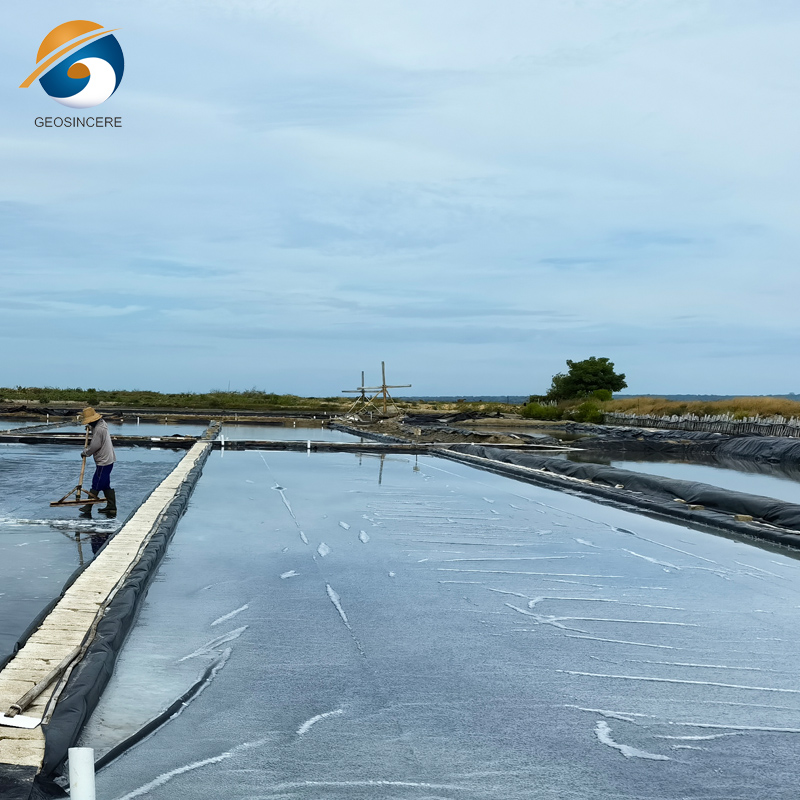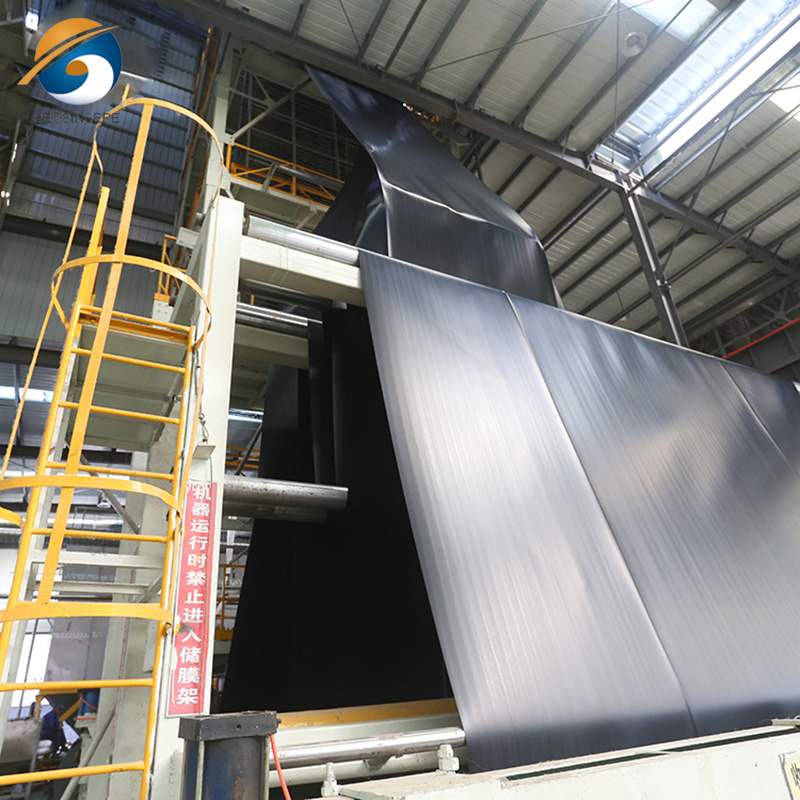Resistance UV Waterproof Geomembrabe Liner for Salt Industry
Waterproof geotextile liner that blocks ultraviolet rays is a crucial material in the salt industry, specifically designed to address common challenges in salt field environments. This type of geomembrane is usually made of high-density polyethylene (HDPE) and is widely used due to its excellent durability and corrosion resistance. Its main function is to provide an effective waterproof barrier, preventing water infiltration and pollutants from entering the salt field, thereby protecting the purity and quality of the salt. In addition, its UV resistance enables it to withstand direct sunlight exposure, avoiding material failure caused by UV degradation and significantly extending its service life. In the application of salt industry, this geomembrane can not only improve production efficiency, but also effectively reduce environmental impact, ensuring the friendliness of the production process to the natural ecology. Overall, waterproof geomembranes that block ultraviolet radiation are essential key materials in modern salt production, providing solid support for salt field operations.
In the harsh, saline, and highly UV-exposed environments of the salt industry, ensuring long-term containment and evaporation efficiency requires specialized materials. A Resistance UV Waterproof Geomembrane Liner is engineered to meet these unique demands, delivering robust performance in salt pans, brine ponds, and crystallization beds. This article offers a comprehensive, technically detailed exploration of geomembrane liners specifically designed for the salt industry, focusing on their materials, UV resistance, waterproofing capabilities, installation, and relevant industry standards.
What Is a Resistance UV Waterproof Geomembrane Liner?
A geomembrane liner is a low-permeability synthetic membrane used to control fluid migration. For salt industry use, these liners are typically manufactured from UV-stabilized High-Density Polyethylene (HDPE) or Linear Low-Density Polyethylene (LLDPE)—materials known for their chemical resistance, impermeability, and UV durability.
Key Characteristics:
UV Resistance: >80% retention after 20,000 hours of accelerated UV testing
Salt Resistance: Chemically inert against NaCl, MgCl₂, and other brine components
Waterproofing: Hydraulic conductivity < 1×10⁻¹³ cm/s
Service Life: 20–30 years in exposed outdoor salt field applications
Applications in the Salt Industry
Salt Crystallization Beds
Prevents salt loss through infiltration
Enhances yield by promoting uniform brine evaporation
Brine Evaporation Ponds
Maintains chemical stability of brine solution
Minimizes contamination of surrounding soils or groundwater
Leachate and Wastewater Containment
Used for managing saline wastewater during salt refinement
Lining of Salt Storage Areas
Prevents groundwater contamination and salt leaching
Material Composition and Technical Specifications
| Component | Specification | Standards |
|---|---|---|
| Base Material | HDPE or LLDPE | ASTM D1505, ISO 1133 |
| Thickness Range | 0.75 mm – 2.5 mm | ASTM D5199 |
| UV Stabilizer Content | ≥2.0% (Carbon Black or HALS) | ASTM D4218 |
| Tensile Strength | ≥28 MPa | ASTM D638 |
| Elongation at Break | ≥700% (LLDPE), ≥450% (HDPE) | ASTM D6693 |
| Puncture Resistance | ≥500 N | ASTM D4833 |
| Seam Strength | ≥90% of parent material | ASTM D6392 |
| Chemical Resistance | Stable in high-saline, acidic, and alkaline environments | ASTM D543 |
Engineering Considerations in Design
1. UV Exposure & Longevity
Salt fields are typically located in high solar irradiance regions. Geomembranes must incorporate carbon black dispersion or Hindered Amine Light Stabilizers (HALS) to prevent polymer chain degradation.
2. Chemical Compatibility
Brine and associated compounds like CaCl₂, KCl, MgSO₄ demand materials with exceptional chemical inertness. HDPE outperforms PVC or EVA in such scenarios.
3. Surface Friction & Wind Uplift
Open salt pans are susceptible to wind. Use of textured geomembranes improves interlayer friction and reduces slippage or uplift during strong gusts.
4. Thermal Expansion
Daily temperature swings affect liner dimension. Use LLDPE liners where flexibility under stress is required.
Installation Guidelines for Salt Fields
Subgrade Preparation
Compact surface to 95% Proctor density
Remove all sharp objects and irregularities
Deployment
Panels unrolled during early morning or late afternoon to minimize thermal tension
Overlaps: Minimum 100 mm side, 150 mm end
Seaming
Dual-track hot wedge welding
Field seams must be tested using air channel or vacuum box method
Ballasting and Protection
Use sandbags or protective geotextiles to anchor liner edges against wind
Optional: Cover exposed areas with reflective white geomembranes to reduce thermal aging
Standards and Regulatory Guidelines
ASTM D5883 – Geomembrane seam strength evaluation
GSI-GM13 – HDPE geomembrane specification by Geosynthetic Institute
ISO 9862 / 9863 – Determination of thickness and mass per unit area
GB/T 17643-2011 – Chinese standard for composite geomembranes
ISO 9001 / CE Certification – Manufacturing quality compliance
Case Example: Salt Pan Project in Coastal Gujarat, India
Material Used: 1.5 mm UV-resistant HDPE geomembrane
Area Covered: 120,000 m²
Results:
Brine leakage reduced by 99.7%
Harvest cycle efficiency improved by 18%
10-year service life with no visual degradation
Frequently Asked Questions
Q1: What is the minimum thickness for salt field applications?
A: A minimum thickness of 1.0 mm is recommended, but 1.5 mm is standard for long-term UV exposure.
Q2: Can these geomembranes be installed during high temperatures?
A: Yes, but welding efficiency drops above 45°C ambient. Install early morning and test every seam.
Q3: Are black geomembranes better for UV resistance?
A: Yes. Black geomembranes with carbon black content (≥2%) offer the highest UV protection among all colors.
Q4: How are defects in field seams detected?
A: Non-destructive air channel testing and vacuum box testing (ASTM D5820) are standard for on-site verification.
Conclusion
Resistance UV Waterproof Geomembrane Liners are indispensable for the salt industry, offering unmatched performance in seepage control, UV resistance, and chemical stability. When specified and installed correctly, they dramatically extend the operational life of salt pans and reduce maintenance costs.
Engineers and operators must select certified materials and follow rigorous quality control during installation. For long-term brine containment and salt recovery efficiency, a well-designed geomembrane system is not a luxury—it is a necessity.












